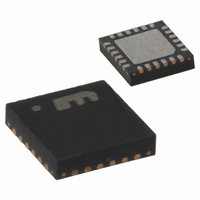MIC3001GML Micrel Inc, MIC3001GML Datasheet - Page 26

MIC3001GML
Manufacturer Part Number
MIC3001GML
Description
IC FOM MANAGEMENT W/CALIBR 24MLF
Manufacturer
Micrel Inc
Type
Transceiverr
Datasheet
1.MIC3001GML.pdf
(76 pages)
Specifications of MIC3001GML
Protocol
SDHj Sonet
Voltage - Supply
3 V ~ 3.6 V
Mounting Type
Surface Mount
Package / Case
24-MLF®, QFN
Lead Free Status / RoHS Status
Lead free / RoHS Compliant
Number Of Drivers/receivers
-
Other names
576-1753-5
MIC3001GML
MIC3001GML
Available stocks
Company
Part Number
Manufacturer
Quantity
Price
Company:
Part Number:
MIC3001GML
Manufacturer:
Micrel Inc
Quantity:
1 801
Part Number:
MIC3001GMLTR
Manufacturer:
MICREL/麦瑞
Quantity:
20 000
Micrel, Inc.
the fault comparators. Since laser bias current varies
greatly with temperature, there is a temperature
compensation look-up table for the bias current fault DAC
value.
When a fault condition is detected, the laser will be
immediately shutdown and TXFAULT will be asserted.
The V
driven to their shutdown state according to the state of the
configuration bits. The shutdown states of V
and SHDN versus the configuration bit settings are shown
in Table 10, Table 11, and Table 12.
SHDN and TXFIN
SHDN and TXFIN are optional functions of pin 7. SHDN
is an output function and is designed to drive a redundant
safety switch in the laser current path. TXFIN is an input
function and serves as an input for fault signals from
external devices that must be reported to the host via
TXFAULT.
applications in which the MIC3001 is performing all APC
and laser management tasks. The TXFIN function is for
situations in which an external device such as a laser
diode driver IC is performing laser management tasks,
including fault detection.
If the TXFIN bit in OEMCFG3 is zero (the default mode),
SHDN will be activated anytime the laser is supposed to
be off. Thus, it will be active if 1) TXDISABLE is asserted,
2) STXDIS in CNTRL, is set, or 3) a fault is detected.
SHDN is a push-pull logic output. Its polarity is
programmable via the SPOL bit in OEMCFG1.
If TXFIN is set to one, pin 7 serves as an input that
accepts fault signals from external devices such as laser
diode driver ICs. Multiple TXFAULT signals cannot simply
be wire-ORed together as they are open-drain and active
high. The input polarity is programmable via the TXFPOL
bit in OEMCFG3. TXFIN is logically ORed with the
MIC3001’s internal fault sources to produce TXFAULT
and determine the value of the transmit fault bit in
CNTRL. See Figure 9.
August 2004
MOD
, V
BIAS
The
Figure 10. Saturation Detector
, and SHDN (if enabled) outputs will be
SHDN
function
is
designed
MOD
, V
BIAS
for
,
Temperature Measurement
The temperature-to-digital converter for both internal and
external temperature data is built around a switched current
source and an eight-bit analog-to-digital converter. The
temperature is calculated by measuring the forward voltage
of a diode junction at two different bias current levels. An
internal multiplexer directs the current source’s output to
either an internal or external diode junction. The value of the
ZONE bit in OEMCFG1 determines whether readings are
taken from the on-chip sensor or from the XPN input. The
external PN junction may be embedded in an integrated
circuit, or it may be a diode-connected discrete transistor.
This data is also used as the input to the temperature
compensation look-up tables. Each time temperature is
sampled and an updated value acquired, new corrective
values for IMOD and the APC setpoint are read from the
corresponding tables, added to the set values, and
transferred to DACs.
Diode Faults
The MIC3001 is designed to respond in a failsafe manner to
hardware faults in the temperature sensing circuitry. If the
connection to the sensing diode is lost or the sense line is
shorted to V
the A/D converter will be forced to its full-scale value
(+127°C). The diode fault flag, DFLT, will be set in
OEMCFG1, TXFAULT will be asserted, and the high
temperature alarm and warning flags will be set. The
reported temperature will remain +127°C until the fault
condition is cleared. Diode faults may be reset by toggling
TXDISABLE, as with any other fault. Diode faults will not be
detected at power up until the first A/D conversion cycle is
completed. Diode faults are not reported while TXDISABLE
is asserted.
Temperature Compensation
Since the performance characteristics of laser diodes and
photodiodes change with operating temperature, the
MIC3001 provides a facility for temperature compensation
of the A.P.C. loop setpoint, laser modulation current, bias
current fault comparator threshold, and bias current high
alarm flag threshold. Temperature compensation is
26
Figure 11. RXLOS Comparator Logic
DD
or ground, the temperature data reported by
hbwhelp@micrel.com
or (408) 955-1690
M9999-082404-A
MIC3001












